Right Fit Revolution
Don’t Overpay for College
The Rankings Trap EXPOSED
How a Broken System Hijacked College Dreams
(And How Our Families Can Break Free)
Choosing a college feels like one of the biggest decisions of our kids’ lives — and ours.
Rightfully so.
There’s info coming at us from every direction: counselors, websites, tours, forums, friends… not to mention the 3 a.m. panic spiral in our own brains.
We just want to help our kids make a smart choice. To find a place where they’ll be happy, successful, and set up for a good life.
So when a glossy brochure arrives in the mail from a “Top 20 school,” proudly displaying its Best Colleges badge, it feels like a mental shortcut.
A signal that says: This one will make them happy and successful. This one’s worth the massive financial investment we’ll be making.
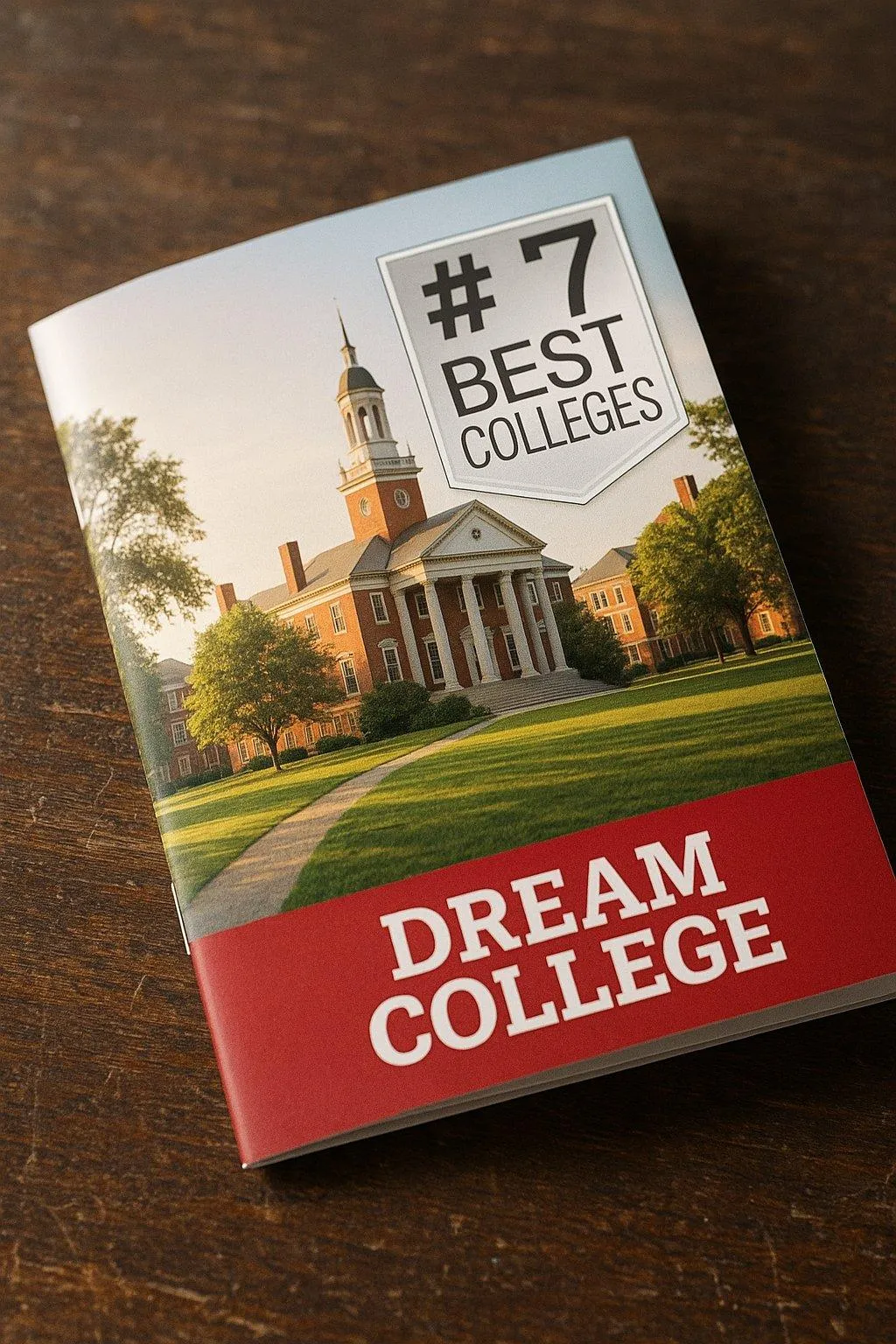
But here’s the truth: The rankings weren’t created to guide families to make smart choices.
They were created by a failing magazine to drive profit — and colleges quickly learned how to game the system to boost their applicants and image. The more trust families place in those numbers, the more “The College-Industrial Complex” profits off our fear, as we stretch for a dream that might not be delivered.
We’ve been manipulated.
And the sooner we see through the lies, the better choices we can make for our kids’ and our future.
It’s time to pull back the curtain… so we can all break free.
A Marketing Stunt That Became a Monster
Let’s start with the origin story almost no one talks about:
In the 1980s, U.S. News & World Report was a struggling magazine looking for a way to boost sales.
So they came up with an idea: rank colleges, just like Consumer Reports ranks washing machines.
It wasn’t about student success. It was a marketing move.
And it worked.
Today, that list reaches over 40 million readers — ten times the number of graduating high school seniors in America.
It’s not just informing decisions. It’s dictating them.
According to a survey by Niche, two-thirds of students, and a whopping 83% of parents, say rankings are important in evaluating a school.
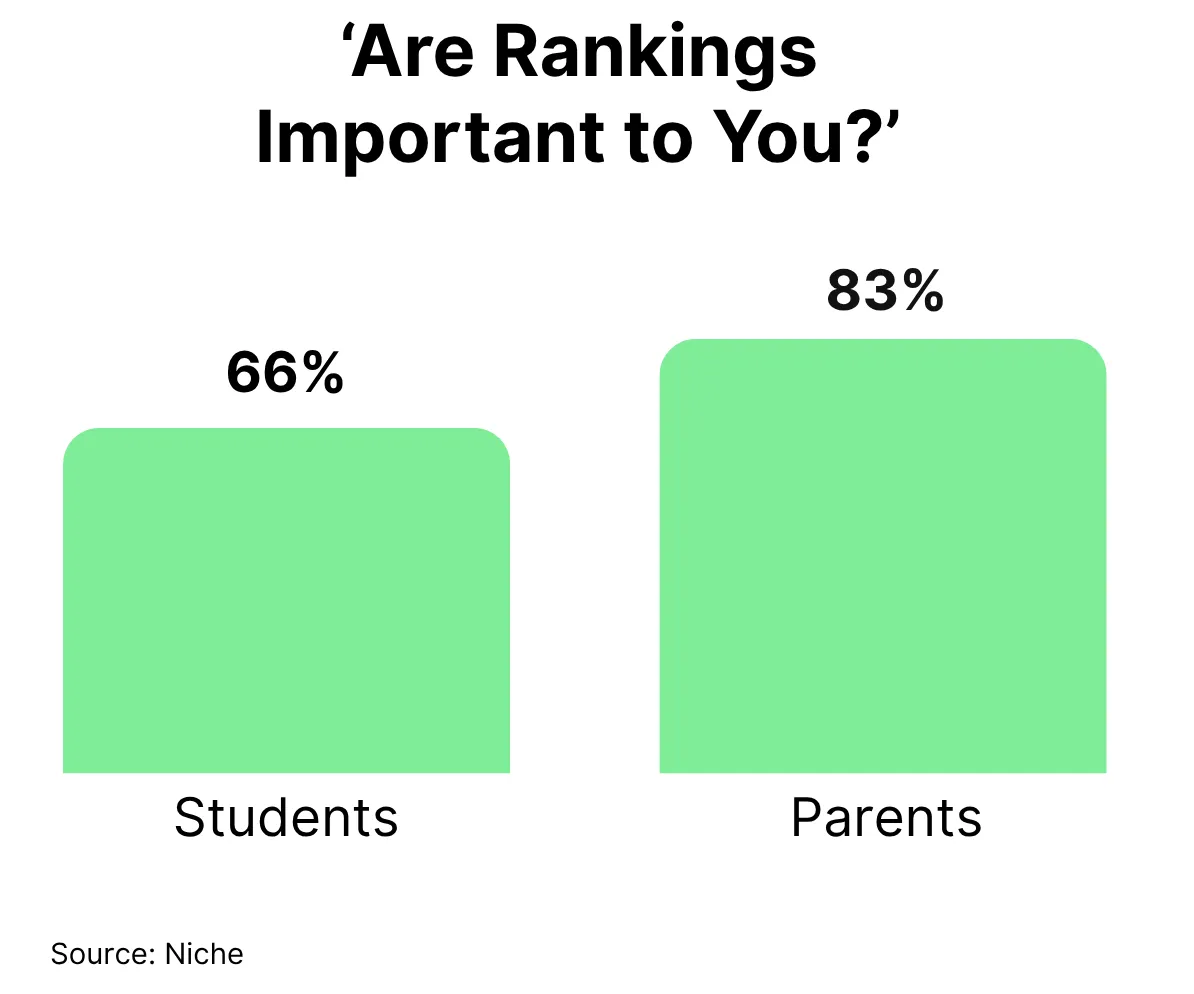
Colleges know this. That’s why many build entire strategies around gaming the ranking system.
That means boosting stats, like lowering acceptance rates, raising test scores, and getting other schools to say nice things about them. (Yes, really. Keep reading...)
Sadly, none of that stat-hacking guarantees your child will be supported, graduate on time, or land a good job.
As a result, families like ours are the ones paying the price, in dollars and disappointment.
We’ve Been Sold a Dangerous Shortcut
Somewhere along the way, even the savviest families started to believe three powerful myths:
Rankings reflect quality.
Prestige guarantees success.
Elite schools are always worth the financial sacrifice.
These myths show up everywhere: in the headlines, the counselor’s office, and the glossy brochures that land in our mailboxes.
It’s no wonder so many of us feel compelled to do “whatever it takes”:
Drain our savings.
Raid our retirement accounts.
Co-sign our kids’ crushing debt.
Because that’s what a “good parent” does, right? You find a way. You make it work. Even if it costs you everything.
But while we’re bending over backwards to do right by our kids — elite colleges and U.S. News are cashing in.
What Rankings Really Measure (And What They Ignore)
What’s most important to you when helping your child choose a college?
Will they be happy there?
Is this school worth the money?
Will they graduate and live a successful life?
Seems obvious, right?
But U.S. News doesn't reward those things in their rankings.
Instead, their biggest weighted factor — a massive 20% — is called “Peer Assessment.”
Each year, college presidents, provosts, and admissions deans are asked to rate hundreds of other schools on a 5-point scale based on their "reputation for undergraduate academic quality."
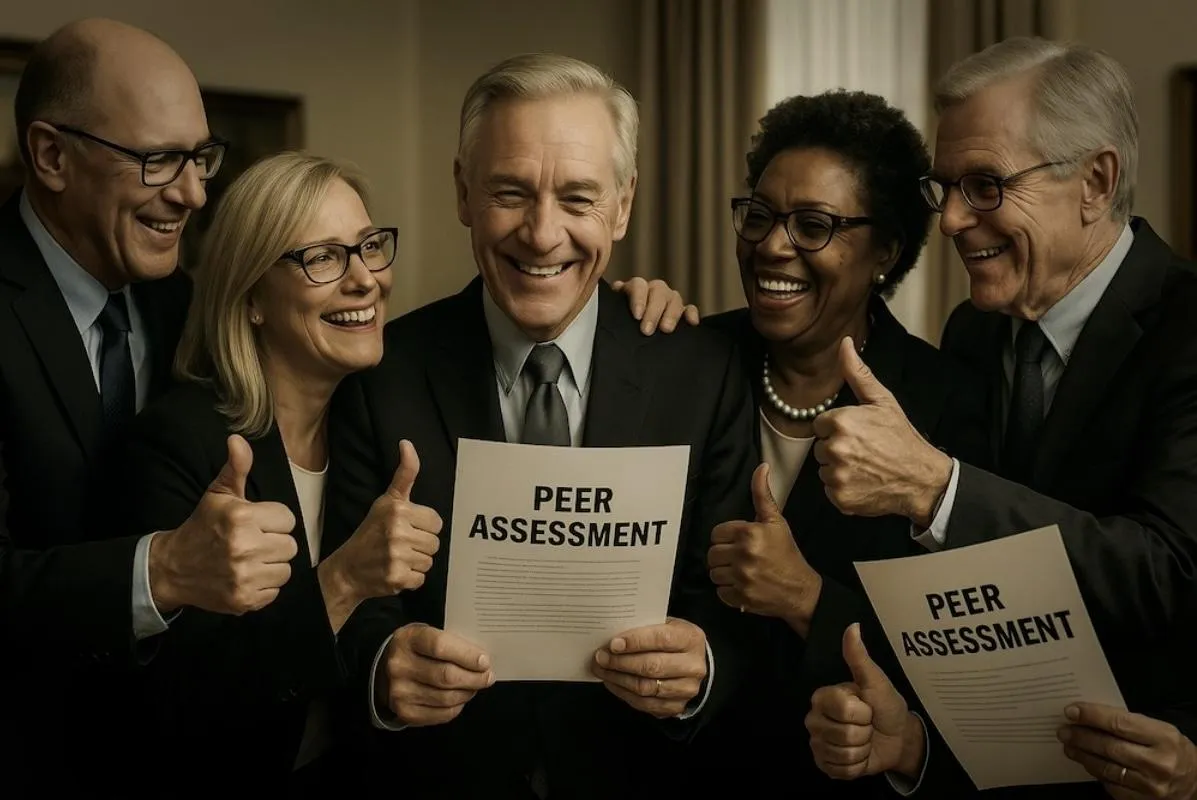
Now you might ask… how could these college presidents possibly have an informed opinion on hundreds of schools — many of which they’ve never visited, researched, or in some cases, even heard of?
They can’t.
“I’m far more qualified to vote for the Baseball Hall of Fame than assess these [colleges].”
-Anonymous Dean, as told to Malcolm Gladwell
Think about it….
Would you trust a food critic’s “Top 100 restaurants in the USA” list, knowing they never set foot in the restaurant or even tasted a dish?
Would you book a $10,000 vacation based on a review written by someone who’s never been there… just “heard it was nice” from other people who haven’t been there either?!?
Of course not!
So why are we expected to trust a metric built on hearsay and guesswork — when what’s at stake is our child’s future and our family’s financial security?
What’s worse, some raters admit that they just copy last year’s rankings when filling out their surveys. Meaning year after year, prestige props up prestige.
What about the things that actually matter to your family? They barely get a glance:
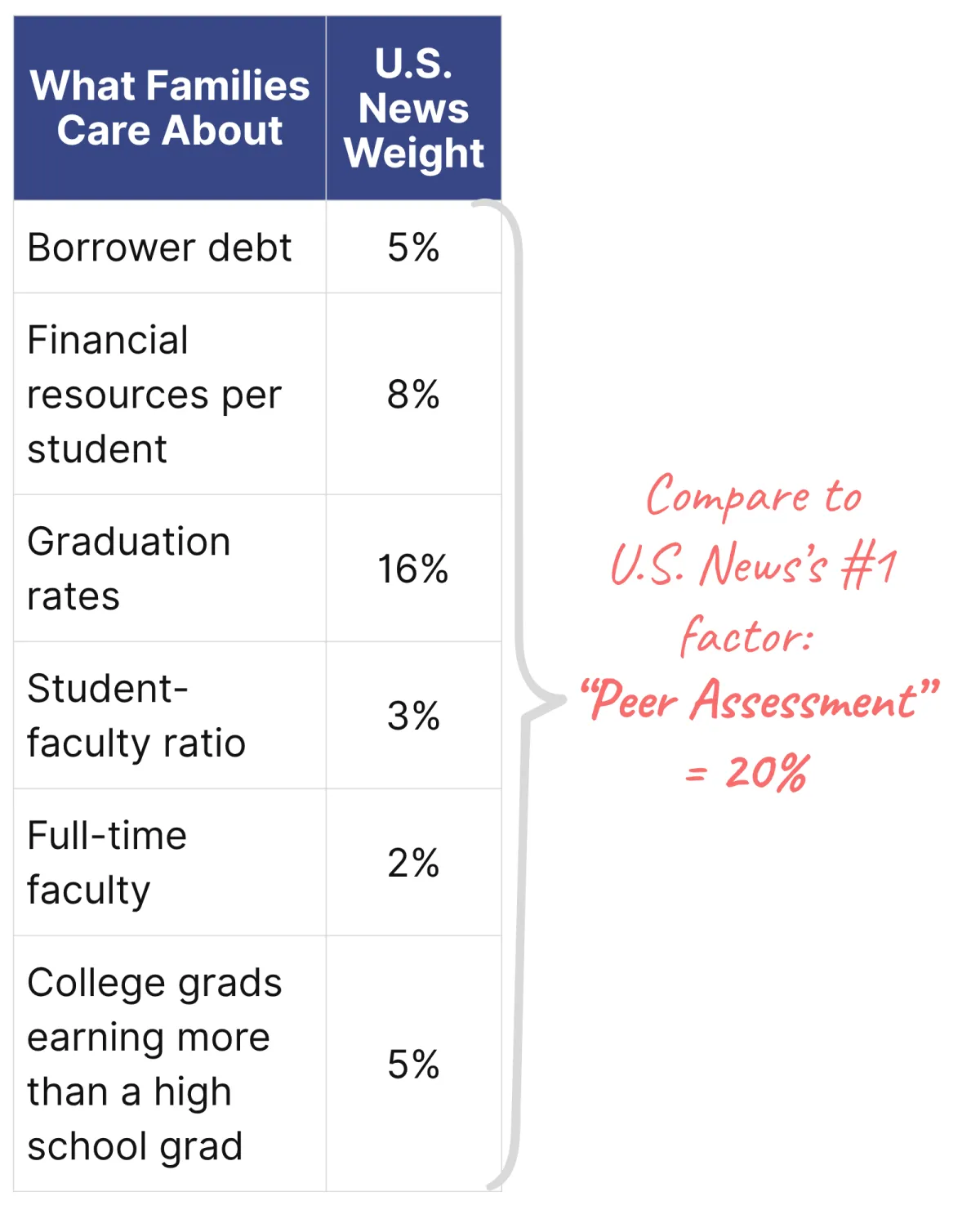
Let that sink in:
A college’s reputation among its peers matters more to U.S. News than whether your child can graduate or afford to pay back their loans.
It’s time we stop letting a flawed ranking system decide what’s right for our kids.
Let that sink in:
A college’s reputation among its peers matters more to U.S. News than whether your child can graduate or afford to pay back their loans.
It’s time we stop letting a flawed ranking system decide what’s right for our kids.
Colleges Know the System Is Broken Too… But They’re Trapped In It
In a 2024 Kaplan survey, college admissions officers were given anonymity to speak openly about what they really think of the college rankings system.
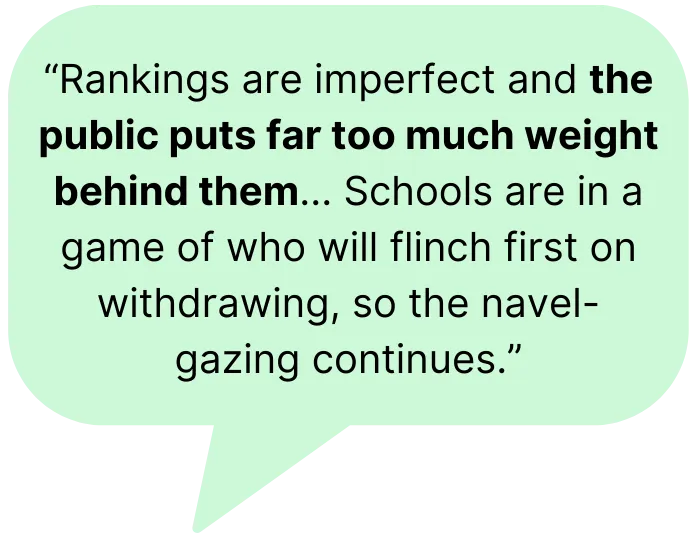
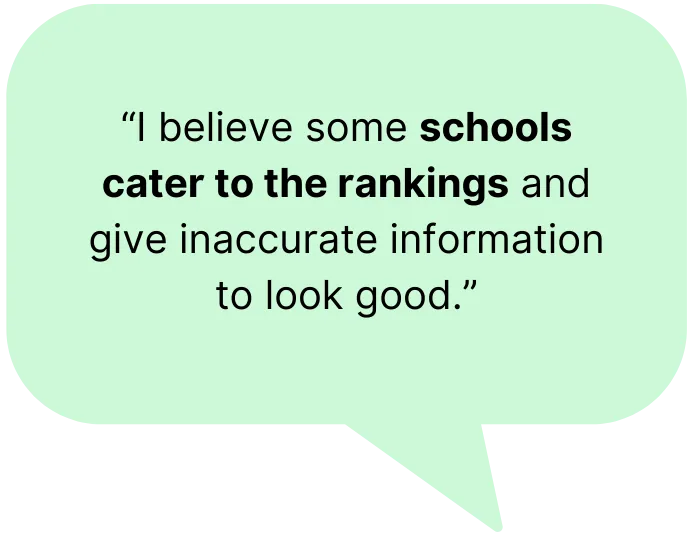
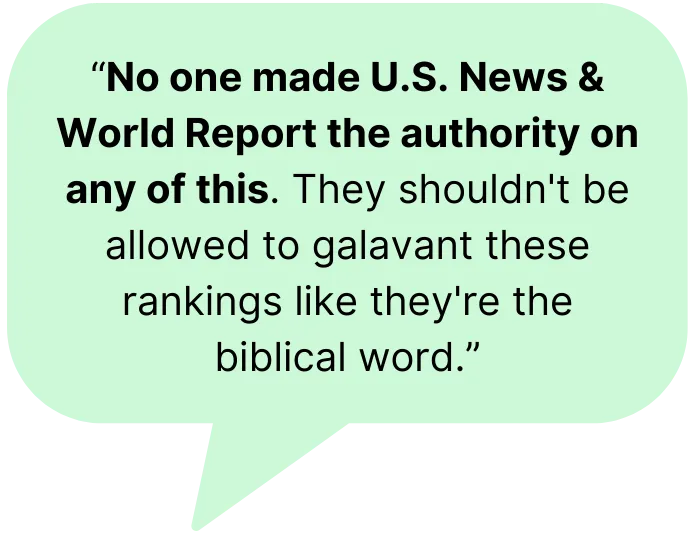
Behind closed doors, they’ll admit what many of us suspect: the rankings are deeply flawed.
And yet, most colleges keep playing along, because they’re afraid to be the first to walk away.
Opting out could mean fewer applications. Lower alumni donations. Losing that illusion of prestige they’ve worked so hard to build.
U.S. News knows this.
That’s why they don’t just rank colleges — they sell them the badge of legitimacy.
According to The New York Times, even schools with modest rankings feel compelled to pay thousands to license these badges. For instance, a public college in Maine paid over $15,000 to promote rankings like “61st for online bachelor’s programs for veterans” and “104th for online bachelor’s degrees.”
Their VP of enrollment aptly called it “the Amazonification of higher education.”
The more schools flaunt those badges, the more they enable and incentivize a system that’s harmful to our kids and us.
It’s a business model disguised as guidance.
“I still cannot believe higher education has paid [U.S. News] to skew what we do in higher education.” — Heather Gerken, Dean of Yale Law School
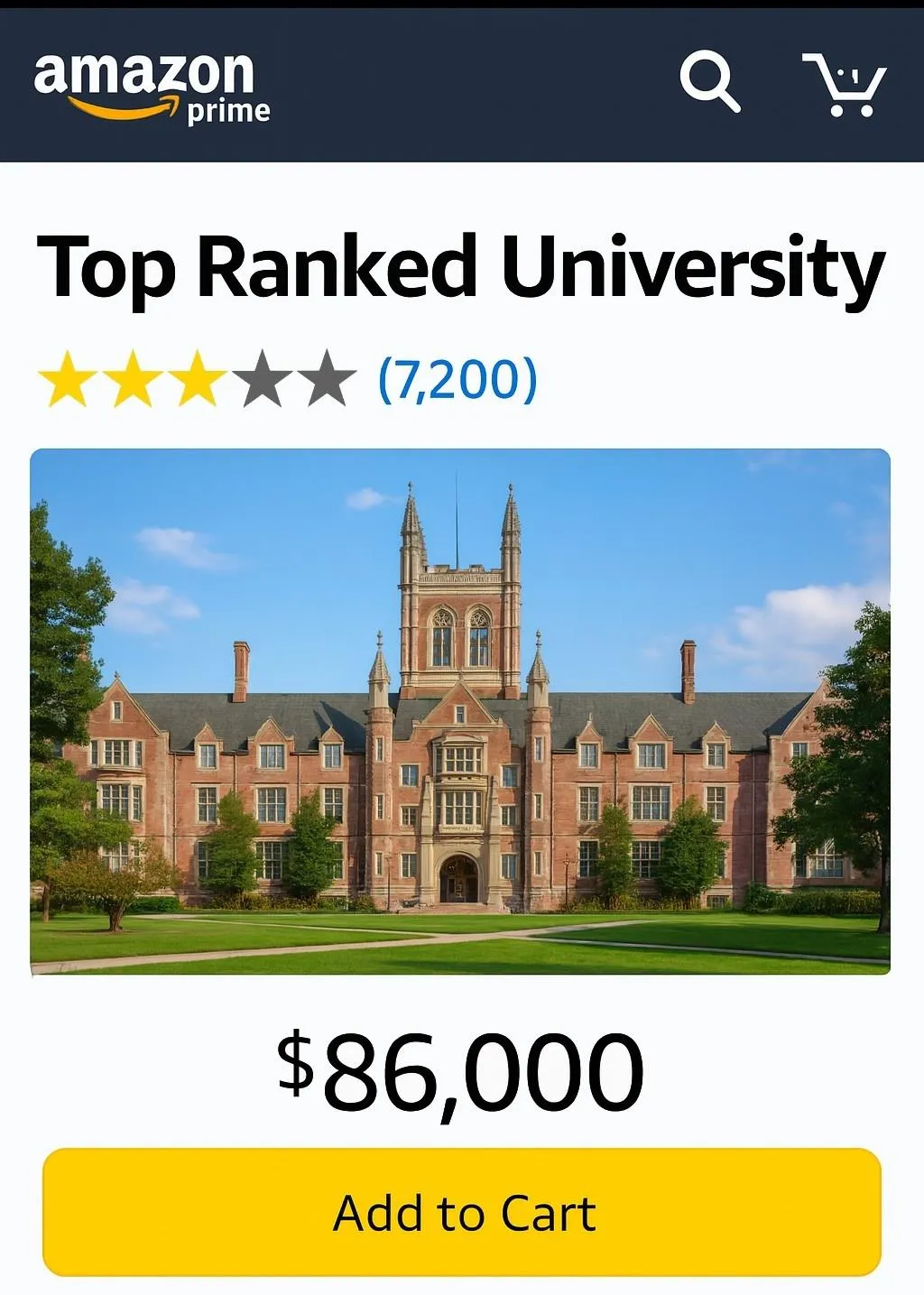
Their VP of enrollment aptly called it “the Amazonification of higher education.”

The more schools flaunt those badges, the more they enable and incentivize a system that’s harmful to our kids and us.
It’s a business model disguised as guidance.
“I still cannot believe higher education has paid [U.S. News] to skew what we do in higher education.” — Heather Gerken, Dean of Yale Law School
How Colleges Game the System (And Break Your Trust)
Now here’s where it really gets crazy.
Colleges aren’t just passively participating in these rankings. Some have built entire institutional strategies around gaming them.
Take, for example, what happened at Northeastern University.
As Boston Magazine reported, in the early 1990s, Northeastern was known as a gritty commuter school with a 75% acceptance rate and low graduation numbers.
Then came a new president and a calculated plan to boost their reputation, not by transforming student outcomes, but by tweaking metrics that influenced the rankings.
They:
Reverse-engineered the U.S. News formula to find every lever they could pull
Capped class sizes at 19 students (just under the threshold that earns “small class” points)
Flooded high school mailboxes with brochures to drive up applications
Rejected more students to make acceptance rates drop and selectivity rise
It worked.
Northeastern vaulted from #162 to the Top 50. Applications soared. Tuition revenue spiked. And suddenly, it looked like a competitive private university.
Former Northeastern President, Richard Freeland, admits proudly:
“There’s no question that the system invites gaming. We made a systematic effort to influence [the outcome].”
-Former Northeastern University President, Richard Freeland
It wasn’t a transformation. It was a rebrand, with families like ours left to foot the bill.
Brace yourself, because this next part might make you angry…
Ever notice how some of the most selective schools send your kid the flashiest brochures?
That’s no accident.
It’s called “Recruit-to-Deny” — and yes, it’s as ugly as it sounds.
Here’s the play:
A school markets to more of our kids, giving them the mistaken-belief they could get in. More kids apply.
The total number of admitted students doesn't change. The school knows they're going to reject those kids.
So the acceptance rate goes down and the school appears more prestigious and ranks higher.
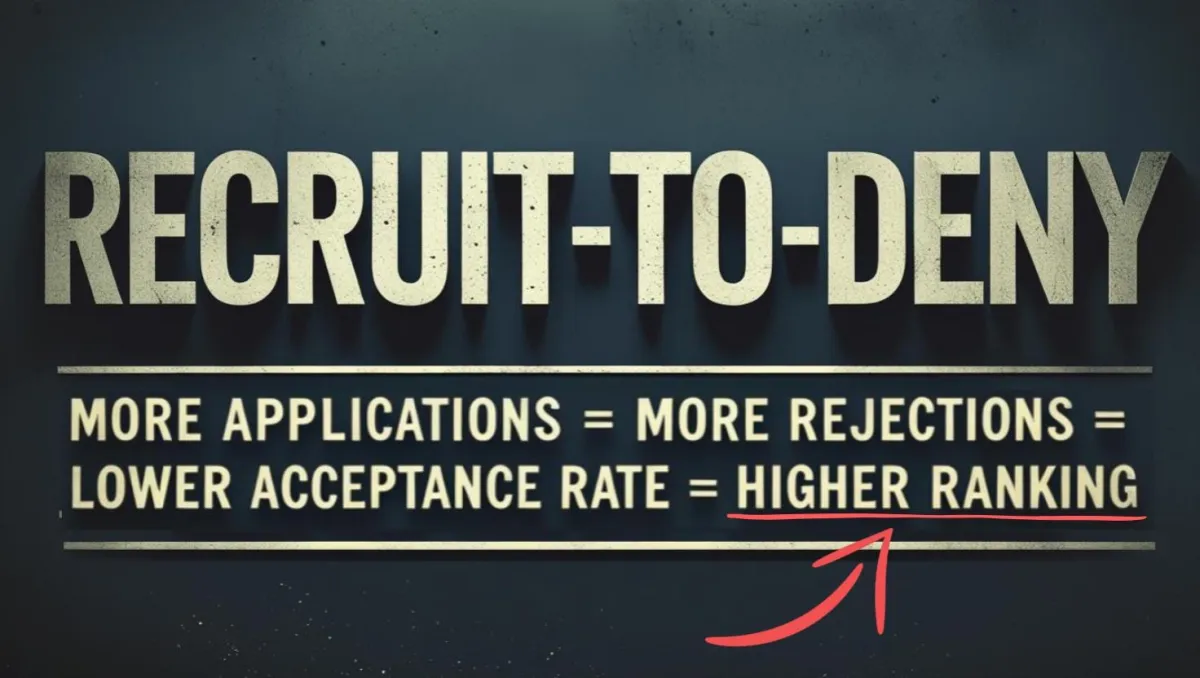
According to a Wall Street Journal report, thousands of kids are recruited just to be rejected. Their disappointment is literally built into the strategy.
The Rankings Hall of Shame
Did you hear about this?
In 2022, Columbia University dropped from #2 to #18 after a math professor (yes, from inside the university!) blew the whistle. As reported in The Guardian, the school had submitted inflated data on class sizes and faculty credentials to boost its score.

That same year, the dean of Temple’s business school was sentenced to 14 months in federal prison for faking data that helped the program hit #1 in U.S. News rankings, according to The Philadelphia Inquirer.
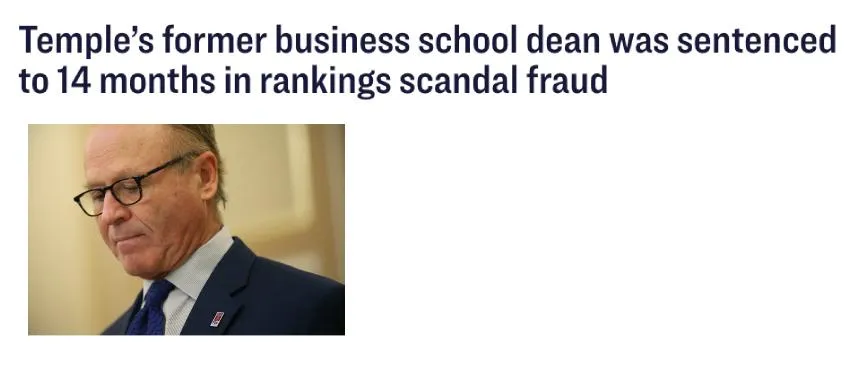
But wait, there’s more…
Multiple schools, including Emory, Claremont McKenna, and University of Southern California, have been caught submitting false test scores or inflated numbers — all in the name of chasing prestige, as reported by Inside Higher Ed, The New York Times, and USC’s own statements.
These aren’t isolated scandals. They’re the symptoms of a broken system.
It’s time to ask ourselves: If even the most “elite” schools are willing to cheat to win the rankings game… what does that tell us about the game?
Rankings Are Driving Up the Price of College
To attract more applicants, increase yield, and ultimately drive rankings, colleges invest in lavish perks.
That includes things like — wait for it — lazy rivers, climbing walls, and gourmet dining halls with chocolate fountains.
You’re not imagining it: Tuition at many colleges has soared past inflation — and sanity.
For comparison, inflation increased 153% between 1989 and 2024.
Here are tuition increases at just a few schools during that same time...
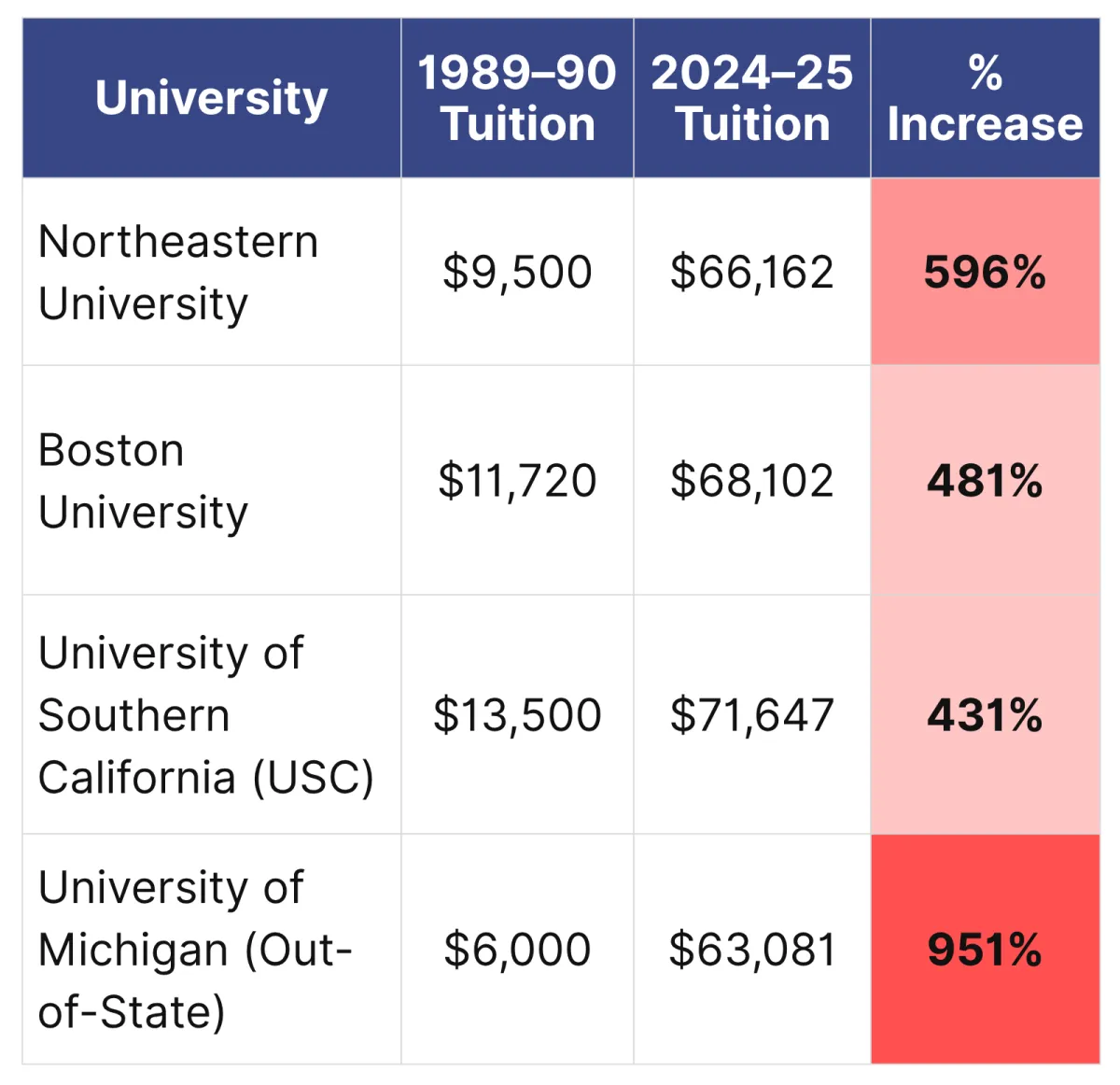
Colleges invest in flash to attract students and climb the rankings — driving prices higher and higher. But none of that spending guarantees your child will thrive, or that you’ll get your money’s worth.
The Bottom Line:
Our Kids Deserve Better
(And We're Here to Help)
Let’s not sugarcoat it: the college rankings game is warped. It wasn’t built to help our children.
It was built to sell a myth, and profit from families trying to do what’s best for our kids.
So let’s break free. ✊
Instead of evaluating schools based on:
A deeply flawed rankings system
Empty prestige games
Meaningless metrics
Let’s choose now to focus on schools that:
Prioritize teaching, mentorship, and student experience
Deliver strong career outcomes
Offer generous merit or need-based aid
Support our children’s personal and academic growth
Don’t trap our families in debt
Because our children’s college years should be a launchpad…. NOT a debt anchor.
Coming up next, we’ll share a simple 3-part framework to help you evaluate schools by what actually matters.
For now, go ahead and EXHALE.
You don’t have to play by the old rules anymore.
You don’t have to let rankings — or anyone else’s idea of success — decide what’s right for your child.
There’s a smarter way forward.
One where your family stays in control. Where your child can thrive and graduate with real options and freedom.
Because you don’t need a number to tell you what’s right.
You just need the truth…and the tools to act on it. That’s what we’re giving you.
Ready to discover
The Right Fit Framework™?
Sources Consulted
Revisionist History - Malcolm Gladwell Podcast, "Lord of the Rankings."
U.S. News & World Report, "Best Colleges Rankings."
Boston College Fact Book.
University of Michigan: Bentley Historical Library.
Daily Trojan.
Federal Reserve Bank of Minneapolis.
Western Interstate Commission for Higher Education (WICHE), "U.S. High School Graduates Will Peak Next Year, Then Most States Will See Steady Declines Through 2041."
Niche.com, "2022 Survey of College-Searching Parents."
U.S. News & World Report, "How U.S. News Calculated the Rankings."
Boston Magazine, "How to Game the College Rankings," August 26, 2014.
The Washington Post, "Are Colleges Gaming Their Applicants?," March 5, 2015.
The Philadelphia Inquirer, "Former Temple Business School Dean Sentenced to 14 Months for Falsifying Data to Boost Rankings," March 11, 2022.
Inside Higher Ed, "Sorry, Wrong Numbers," August 20, 2012.
The New York Times, "College Says It Exaggerated SAT Figures for Ratings," January 30, 2012.
University of Southern California (USC) Rossier School of Education, "Why USC Rossier Will Not Participate in U.S. News Ranking Going Forward," March 2022.
Forbes, "Why Lazy Rivers Have Their Place on College Campuses — And Yet Still Might Just Be Lazy," November 14, 2019.
Kaplan, "2024 Survey of Admissions Officers on College Rankings."
The New York Times, "How U.S. News’ College Rankings Took Over Higher Education," January 6, 2024.
